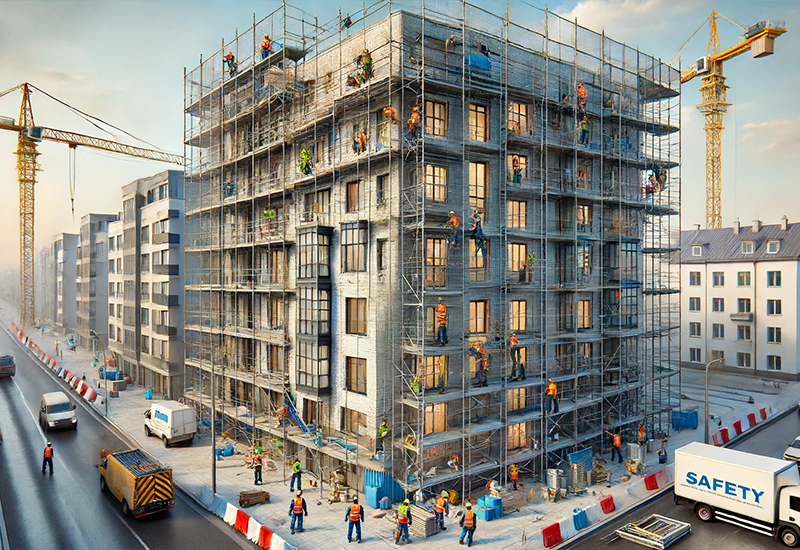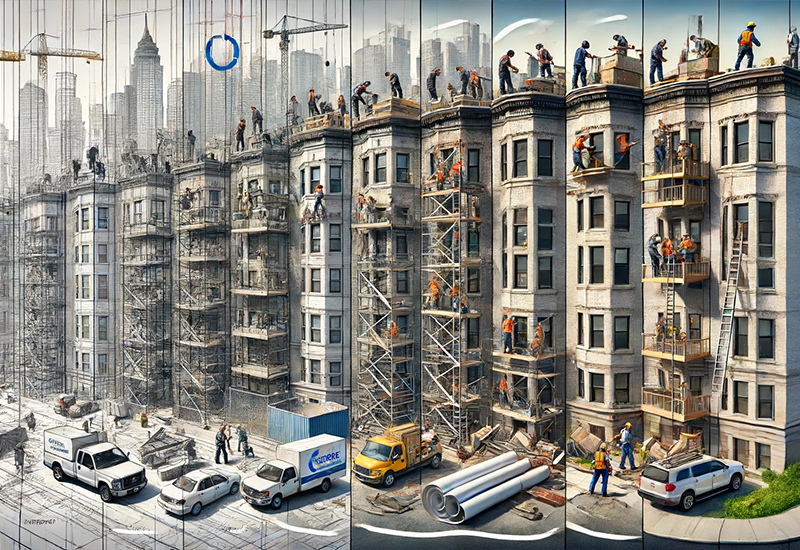
Local Law 11 requirements in New York City mandate that building owners conduct regular façade inspections to ensure structural safety. By adhering to Local Law 11 requirements, property owners safeguard pedestrians and residents from potential hazards, meeting legal standards while maintaining building integrity. Understanding these requirements is crucial for compliance and preventing legal liabilities.
Table of Contents
What is Local Law 11?
Local Law 11, formally enacted in 1998, is a critical part of New York City’s administrative code that mandates the owners of buildings taller than six stories to undertake thorough inspections of their exterior walls and appurtenances every five years. This law evolved from its predecessor, Local Law 10 of 1980. City officials initiated Local Law 10 in response to a series of incidents where falling façade pieces endangered pedestrians. The need for stricter regulations became apparent, leading to the introduction of Local Law 11 to enhance urban safety and maintain structural integrity in the bustling city.
Why is Local Law 11 Important?
The significance of Local Law 11 cannot be overstated as it plays a pivotal role in safeguarding public safety. By requiring regular and detailed inspections of building exteriors, the law aims to protect pedestrians and residents from the potential hazards posed by façade deterioration. For building owners, compliance is not merely about adhering to legal standards; it’s about taking proactive steps to prevent accidents and minimize legal liabilities. Ensuring that buildings meet the stringent requirements of Local Law 11 helps in maintaining the aesthetic and structural standards of the urban landscape, thereby supporting the overall safety and livability of New York City.
Detailed Inspection Process Under Local Law 11
The inspection process under Local Law 11 is structured to ensure that all buildings not only meet the current safety standards but also maintain them consistently over time. Let’s break down the steps involved in this thorough inspection process:
1. Initial Evaluation
The initial evaluation is the first crucial step under Local Law 11. During this phase, qualified professionals, such as licensed architects or engineers, are tasked with conducting a comprehensive examination of the building’s exterior. This includes a close inspection of walls, roofs, balconies, and all appurtenances to identify any structural issues or wear that could pose a risk. The purpose of this evaluation is to assess the current state of the building’s facade and determine if there are any immediate safety concerns that need to be addressed.
2. Reporting
Once the initial evaluation is complete, the next step involves detailed reporting. The professionals responsible for the inspection are required to prepare and submit a detailed report to the Department of Buildings (DOB). This report categorizes the building’s facade into one of three categories:
- Safe: The facade does not show any signs of deterioration that could pose hazards.
- Unsafe: Immediate hazards are present, and the facade requires prompt intervention to ensure safety.
- Safe with a Repair and Maintenance Program (SWARMP): The facade is currently safe, but it has deficiencies that you need to address in the near future to prevent them from becoming unsafe.
This categorization helps the DOB track the condition of buildings and ensures that owners are aware of their responsibilities toward maintaining their properties.
3. Repair and Maintenance
Following the reporting, the final crucial phase is repair and maintenance. If the inspection report identifies any issues, especially those categorized as unsafe or SWARMP, the building owner must undertake timely repairs. This step is vital as it directly addresses any identified hazards, ensuring they are rectified before they can pose a risk to public safety. The law stipulates specific timelines within which you must complete these repairs, emphasizing the urgency of correcting unsafe conditions.
For buildings categorized under SWARMP, owners must rectify the issues within a given timeframe. This proactive approach ensures that you manage minor issues before they escalate into significant hazards, thus maintaining the safety and integrity of the building’s exterior over time.
Timeline for Compliance

Compliance with Local Law 11 involves a clear timeline from the initial inspection to the completion of any required repairs. This timeline is crucial for building owners to understand so they can plan and execute necessary actions without facing penalties.
1. Initial Inspection
The compliance process begins with the initial inspection, which you must conduct within the five-year cycle specified by the Department of Buildings (DOB). Once a new cycle starts, building owners have a specific window, usually within the first two years, to complete this initial inspection.
2. Filing of the Report
After the inspection is completed, the findings must be documented and reported to the DOB. The report must categorize the façade as safe, unsafe, or safe with a repair and maintenance program (SWARMP). Building owners have a deadline, typically within 60 days from the inspection date, to file this report. Failing to meet this deadline can result in fines and further legal implications.
3. Completion of Repairs
- For Unsafe Conditions: Immediate action is required. The law mandates that building owners must begin repairs within 30 days of filing the report and complete them within 90 days, although they can request extensions based on the extent of repairs needed.
- For SWARMP Conditions: Repairs should be scheduled before the next inspection cycle. Owners must monitor and maintain the façade to prevent any deterioration from becoming unsafe.
4. Documentation of Repairs
Upon completing all necessary repairs, you must submit a follow-up report to the DOB, confirming that the building now complies with the safety standards. This report serves as a record that you have addressed all identified issues.
5. Planning for the Next Cycle
Once compliance is achieved for one cycle, building owners should start planning for the next. This includes budgeting for inspections and potential repairs, maintaining good records, and staying informed about any changes in the legal requirements.
Compliance Timeline for Local Law 11
| Phase | Action Required | Deadline |
| Initial Inspection | Conduct a thorough inspection of the façade. | Must be completed in the first 2 years of the cycle |
| Report Filing | File the inspection report with the DOB. | Submission required within 60 days of inspection |
| Repairs (Unsafe Conditions) | Begin necessary repairs. | Start within 30 days of report filing |
| Repairs Completion (Unsafe) | Finish all repairs. | Must be done within 90 days of starting repairs |
| Repairs (SWARMP Conditions) | Plan and carry out repairs. | Should be completed before the next inspection cycle |
| Documentation of Repairs | Submit a follow-up report to the DOB. | Immediately after repairs |
Common Challenges and Solutions
Compliance with Local Law 11 involves navigating several common challenges that building owners in New York City face. Let’s dive into these challenges and explore practical solutions.
Access to Building Exteriors
Challenge: In the dense urban environment of New York City, accessing the exteriors of tall buildings for inspection and repairs can be tricky. The close proximity of buildings, busy streets, and the continuous presence of pedestrians and traffic complicate the use of equipment like scaffolds and ladders.
Solution: Employing professional rigging solutions is an effective way to overcome these obstacles. Rigging involves setting up mechanical systems that allow inspectors and repair crews to safely access hard-to-reach areas of a building’s facade. Building owners should hire experienced professionals who specialize in urban rigging, ensuring that all safety regulations are met. This approach not only facilitates thorough inspections but also speeds up the repair process, minimizing disruptions to the surrounding area.
Cost Management
Challenge: Budgeting for the mandatory inspections and subsequent repairs required by Local Law 11 can be daunting. The potential for unforeseen expenses arising from the discovery of significant facade issues can add to the financial strain.
Solution: Strategic long-term planning and phased repairs can greatly alleviate financial pressure. Here’s how:
- Long-term Budgeting: Building owners should include façade inspections and potential repairs in their long-term budget planning. This proactive approach allows for the accumulation of funds over time, reducing the impact of large, one-time expenses.
- Phased Repairs: If the inspection reveals that repairs are needed, you can manage costs more effectively by implementing them in phases. Prioritizing repairs based on urgency and safety implications allows building owners to spread out expenses while still maintaining compliance and ensuring safety.
How to Ensure Compliance with Local Law 11
Ensuring compliance with Local Law 11 is crucial for building owners in New York City to maintain the safety of their structures and avoid potential penalties. Here’s a step-by-step guide to help navigate the compliance process effectively.
Understanding DOB Guidelines
Step 1: Educate Yourself on the Requirements
The first step to ensuring compliance is to thoroughly understand the Department of Buildings (DOB) guidelines. These guidelines outline the specific requirements for façade inspections, reporting formats, deadlines, and the qualifications needed for professionals conducting these inspections. You can access these guidelines directly from the DOB’s website or consult with a professional who specializes in local law compliance.
Step 2: Stay Updated on Changes
Regulations and requirements can evolve, so it’s crucial to stay informed about any updates or changes to Local Law 11. Subscribing to DOB newsletters, attending relevant seminars, and maintaining communication with legal and construction professionals are effective ways to keep up-to-date.
Hiring Accredited Professionals
Step 3: Select Qualified Inspectors
Compliance depends significantly on the quality of the inspection. Therefore, hiring accredited professionals—licensed architects or engineers—is essential. Ensure that the professionals you choose are not only qualified but also have experience with Local Law 11 inspections in urban settings.
Step 4: Ensure Proper Documentation
Qualified professionals should not only conduct thorough inspections but also provide detailed reports that meet the DOB’s requirements. These reports should clearly categorize the facade’s condition and outline any necessary repairs or maintenance. Proper documentation is crucial for legal compliance and for planning any required remedial work.
Managing Repair Works
Step 5: Promptly Address Identified Issues
If the inspection report identifies any issues, especially those categorized as unsafe or requiring a SWARMP (Safe With a Repair and Maintenance Program), it is essential to address these issues promptly. Delaying repairs can lead to increased safety risks and higher fines.
Step 6: Verify Repair Quality
After completing the repairs, ensure that the same accredited professional or another qualified inspector verifies the quality and completeness of the work. You should document this verification and submit it to the DOB to confirm that the building now complies with safety standards.
Record Keeping and Reporting
Step 7: Maintain Comprehensive Records
Keep detailed records of all inspections, reports, repair work, and communications with the DOB. These records can be crucial in case of disputes, future inspections, or selling the property.
Step 8: Timely Submission of Compliance Reports
Finally, ensure that you submit all compliance reports and repair documentation to the DOB within the specified deadlines. Timely submission helps avoid penalties and confirms your commitment to maintaining a safe building environment.
Conclusion
Complying with Local Law 11 requirements is essential for ensuring building safety in urban environments. If you’re seeking a professional contractor experienced with Local Law 11, you’re in the right place. For expert advice and services, please contact us at +(1) 917-477-9667 to discuss your specific needs.
FAQs
Q: What are Local Law 11 requirements?
A: Local Law 11 requirements necessitate periodic façade inspections of buildings over six stories in New York City to ensure they are structurally sound and safe.
Q: Why are Local Law 11 requirements important for building owners?
A: Adhering to Local Law 11 requirements helps building owners avoid hefty fines. It ensures their properties are safe for tenants and the public.
Q: Who can perform inspections under Local Law 11 requirements?
A: Licensed professionals such as architects or engineers must perform inspections under Local Law 11 requirements. These professionals should specialize in building exteriors.
Q: What happens if a building fails to meet Local Law 11 requirements?
A: If a building does not meet Local Law 11 requirements, the owner may face penalties. The owner must promptly address any identified issues to comply with city regulations.
Q: How often must buildings comply with Local Law 11 requirements?
A: Buildings must comply with Local Law 11 requirements every five years. They must submit reports to the Department of Buildings detailing the façade’s condition.


